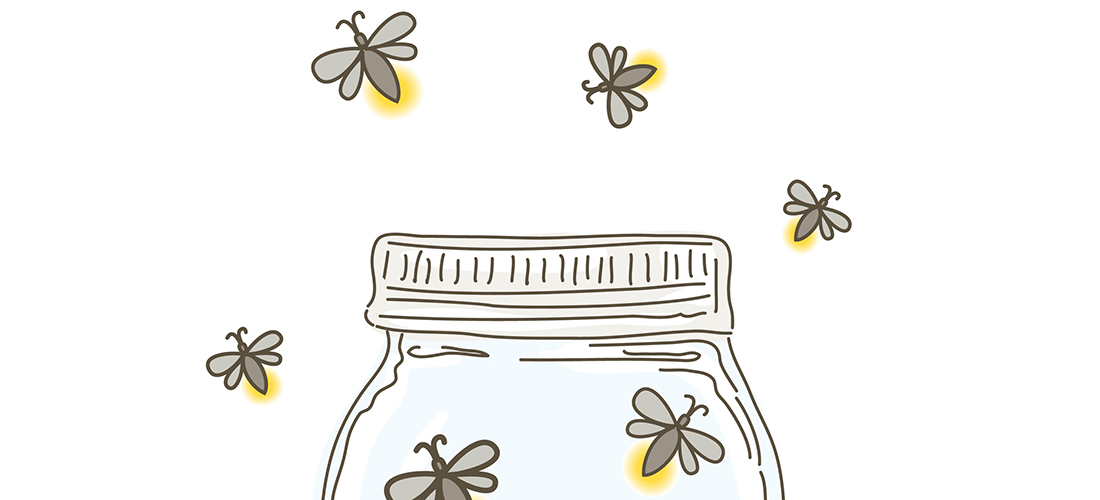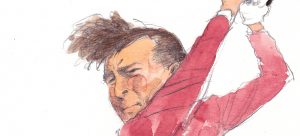
Notes From a Firefly Summer
A message from tiny lights shining in the darkness
By Jim Dodson
Early one morning back in late June — the eve of the summer solstice, as it happened — while I was making coffee in the kitchen before sunrise, I heard a small sound of an animal in distress. I stepped out to our carport and found a baby rabbit lying on his back, his feet lightly kicking, as he looked up at me.
I gently scooped up the little fella, wondering how he’d gotten into such a fix. But then it came to me.
He’d been brought home by one Boo Radley, our young tiger cat who was at present missing his collar and bell. This explained everything. Wearing his bell, Boo Radley is a fairly harmless dude on the prowl. Without it, a feline serial killer and menace to small creatures everywhere. He’d been roaming free for a full week without his collar and bell, which also explained the dead yellow finch I’d found on the stone path beneath the feeder out back and buried in the primroses.
Fortunately the tiny rabbit’s injuries appeared slight. As I carried him across the street to a wild area in my neighbor’s yard where lots of rabbits congregate in the evening, I thought about a couple of books about rabbits that helped to shape my view of life.
The first was Beatrix Potter’s The Tale of Peter Rabbit, which I still own a copy of, given to me by my mother at a very early age, along with Kenneth Grahame’s The Wind in the Willows. These were the first two chapter books I’d read during the solitary summer days in the small Southern town where my father worked for the newspaper.
Before I set him down in the tall grass, I gently massaged the baby rabbit between the ears and gave him the only line from Peter Rabbit that I could recall: “Maybe your mother will put you to bed with some chamomile tea.”
Our neighborhood, which is old and heavily forested, teems with rabbits. We see them in groups on our early morning and evening walks with the dogs. I joke that we actually live in Bunnyland, a vast empire of tunnels and warrens where these small brown herbivores who are either considered a nuisance by gardeners or a sign of ecological harmony by tree huggers — and I am both things, by the way — reside in a world of their own, coming out at the corners of the day to munch on clover and grass and any fool’s unfenced veggie patch. Most are so tame you can walk within a few feet of them.
I freely admit having a soft spot for rabbits, probably because of Peter Rabbit but also because the first living creature I intentionally killed was a rabbit, which I shot one cold afternoon while hunting with my father on Henry Tucker’s farm in the hills west of town. I was 12 or 13. It was late on New Year’s Day. The rabbit stood up as we approached across the stubble of a harvested cornfield, erect as a Presbyterian elder. It was my first hunt. Several young rabbits scampered away in terror but the old rabbit stood his ground on his haunches watching us approach. I leveled my 20-gauge and pulled the trigger without a second thought.
My dad made me take the rabbit home to skin and cook, pointing out his belief that it would be a crime not to honor the rabbit’s life by wasting his flesh. I ate as much of it as I could bear, thinking how, just hours before, this handsome elder of the rabbit race had been out for his last New Year’s walk. Off and on, I dreamed about that rabbit for years.
And I never hunted again.
But I soon learned much more about guns and the brevity of life. When I was 21, my girlfriend was murdered by a 15-year-old kid with a handgun during a botched robbery of a country club in the mountains. Within a few years I was a staffer for the biggest news magazine in the South, covering Atlanta’s record crime wave, interviewing grieving families and coaching a mixed-race baseball team in a city where someone was killing young black kids and tossing their bodies into the Chattahoochee River. The kids on my team and their parents were terrified that they might be next, which is why I drove them home to the federal housing project after practices and games.
During this dark passage of life, I also covered victims of a shooting war on the Texas border with Mexico for a national church magazine, went undercover at a notorious Tennessee game preserve, interviewed convicted murderers, rode with homicide cops, traveled with armed Klansmen and watched a dozen autopsies. One hot August night while walking my dog down our leafy and quiet street in Midtown, I even saw my neighbor shot dead on his porch during a late-night robbery. He was an Emory med student whose promising life went out like a porch light. He died as his hysterical girlfriend and I waited for the emergency medical technicians to arrive.
Somewhere about that time, I read Richard Adams’s leporine masterpiece Watership Down and decided I’d had enough killing. Days after I turned 30, I pulled up stakes and moved to the banks of a green river in southern Vermont where I rented a small cabin heated by firewood that I split by hand. There, I taught myself to fly fish, procured a pup from the local Humane Society, resumed playing golf and read every book I’d ever meant to read including Watership Down for a second — maybe even a third — time. It became my favorite book.
On summer evenings in the wildflower meadow just outside my cabin door, I’d sit until well after dark watching fireflies dance and rabbits feed. Sometimes the rabbits came right up to my doorstep. Amos the dog was fascinated by them but trained not to give chase. Some grew so unafraid of us they hopped right up to him. I think they thought he might be one very big rabbit.
Years later, when I kept a large flower garden on a hilltop in Maine, I made a silent deal with the rabbits and white-tailed deer that inhabited our forest keep. I planted them a summer garden near a vernal spring at the back of our property, where they fed contentedly through the summer and into the fall. In winter, I trudged out under an Arctic moon to dump 50-pound bags of sorghum on the summer feeding spot. I even made up a fanciful tale about a couple of bumbling black bears called Pete and Charlie who dined in our “Animal Garden,” a tale both my now-grown children vividly recall. Pete and Charlie were part of all our lives, and probably will be for a long time.
Magically — or by random luck — the deer and rabbits never ate my Volkswagen-sized hostas or other tender bedding plants. Ours really was a Peaceable Kingdom.
So what do you suppose is a firefly’s true purpose in this world?
My grandmother, Beatrice Taylor, used to say “lightning bugs” were simply God’s way of reminding us of how brief one’s light shines in this world. She refused to let my brother and me collect them in a jar, citing their fragile dance with mortality.
My own belief is that fireflies are in this world simply to delight and make us pause in a darkening landscape, and remember what childhood felt like, inspiring a true sense of awe over a bug that serenely lights up as it goes its way through the uncertain night. What a living metaphor for how to live your own life.
Whatever else can be said of this firefly summer, regardless of a world beyond the neighborhood and childhood imagination that forever appears to be in danger of coming apart at the seams, it’s been a bountiful season of bunnies and fireflies in our neck of the woods — and kids playing in the dark, too.
The other evening we passed a group of a dozen youngsters of various sizes — toddlers to young teens — joyfully playing a game my wife and I both loved to play in the long summer dusks of our childhoods. My Southern neighborhood gang called it “Red light, Green Light,” my wife’s Yankee crowd, “Statue.” The name changes but not the basic idea. These kids called their updated version “Night at the Museum.”
As a central figure shuts eyes and counts out loud, the players attempt to advance “home” without being seen moving when the count is up and the leader’s eyes suddenly open. Players must freeze like rabbits or statues on the lawn. As we watched, a tiny barefoot girl was the first to reach “home”, gleefully slapping hands with the older kids.
Just then we heard a mother’s voice calling to her children, another welcome echo of American childhood. Somewhere in the darkness, young Boo Radley was on the prowl again, a world made safer by his new collar and bell. OH
Contact Editor Jim Dodson at jim@thepilot.com.




